Introduction: An Antwerp Painter of Everyday Scenes
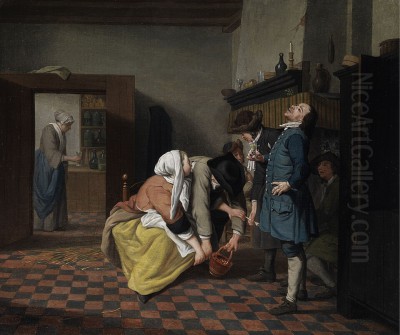
Jan Josef Horemans the Younger, born in the vibrant artistic city of Antwerp in 1714 and active until around 1790 or shortly thereafter, stands as a significant figure in 18th-century Flemish painting. He specialized in genre scenes, capturing the intimate details of daily life in his time. His work provides a valuable window into the social customs, interiors, and activities of the Antwerp bourgeoisie and common folk during a period often overshadowed by the preceding Golden Age of Flemish art. As the son of a painter with the exact same name, his identity and oeuvre are sometimes intertwined with his father's, presenting unique challenges for art historians.
Horemans the Younger operated within a rich tradition of genre painting established by earlier Flemish masters, yet he developed his own distinct approach. His canvases often depict scenes set in private homes, bustling taverns, quiet courtyards, or professional settings like a doctor's surgery. These works are characterized by careful composition, a keen eye for detail, and a narrative quality that invites viewers to piece together the stories unfolding within the frame. He became a master craftsman, adept at rendering textures, fabrics, and the interplay of light and shadow, bringing his miniature worlds to life.
Early Life and Artistic Formation in Antwerp
Baptized in Antwerp on November 16, 1714, Jan Josef Horemans the Younger grew up immersed in the city's artistic environment. Antwerp, though past its 17th-century peak as the dominant artistic center of Northern Europe – a time defined by giants like Peter Paul Rubens, Anthony van Dyck, and Jacob Jordaens – still maintained a lively community of artists and craftsmen. The legacy of detailed realism and the popularity of genre subjects continued to influence painters working in the city.
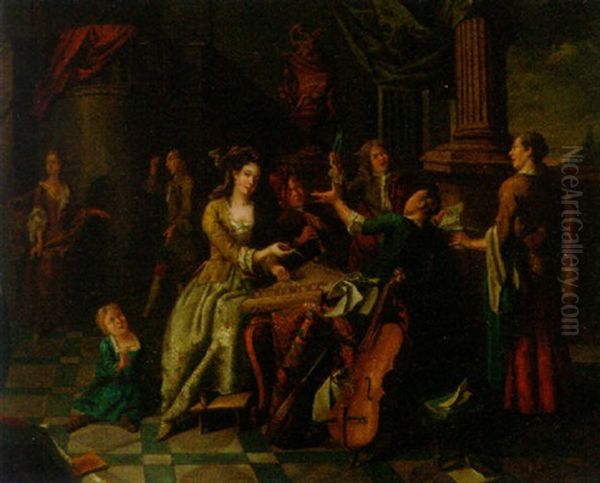
His primary teacher was undoubtedly his father, Jan Josef Horemans the Elder (1682–1759). The elder Horemans was himself a respected painter of genre scenes, known for his depictions of peasant life, interiors, and conversation pieces, often drawing inspiration from the works of Adriaen Brouwer and David Teniers the Younger. Training under his father provided the younger Horemans with a solid foundation in the techniques and thematic concerns that would define his career. He learned the importance of observation, careful draughtsmanship, and the creation of balanced, engaging compositions.
The Horemans Artistic Family: A Source of Confusion
The Horemans family presented a rather unique situation in art history due to the repetition of names. Jan Josef Horemans the Younger shared his exact name with his father, Jan Josef Horemans the Elder. To add to the complexity, records indicate another son of the Elder, also named Jan Josef Horemans, was baptized just weeks earlier in October 1714. While details about this potential twin or close sibling are scarce, it highlights the potential for confusion surrounding the family's artistic output. This shared nomenclature has historically made distinguishing the works of the father from those of the son (or sons) a significant challenge for scholars and collectors.
Jan Josef Horemans the Elder was a prominent figure in the Antwerp Guild of Saint Luke, serving as its dean on several occasions. His style often featured robust figures, somewhat darker palettes, and scenes rooted in the tradition of Brouwer and Teniers. While the Younger clearly learned from his father, his own style gradually evolved. Some critics suggest the Younger's work often displays a lighter touch, more elegant figures, and occasionally incorporates influences from the burgeoning Rococo aesthetic, particularly in his depictions of more affluent social gatherings. However, the stylistic overlap, especially in their earlier periods, remains considerable.
Signatures on paintings often simply read "J. Horemans" or "JH," providing little help in differentiating between the family members. This ambiguity means that attributions must often rely on careful stylistic analysis, comparison with documented works, and considerations of the period in which a painting was likely created. The father's activity peaked in the first half of the 18th century, while the son's career extended well into the latter half.
Artistic Style: Capturing Eighteenth-Century Life
Jan Josef Horemans the Younger excelled in the art of genre painting. His primary focus was the depiction of contemporary life, ranging from simple domestic chores to more elaborate social events. He favored interior settings, meticulously rendering rooms filled with furniture, household objects, and figures engaged in various activities. These settings often include private residences, workshops, schools, and the ubiquitous taverns and inns that were central to social life.
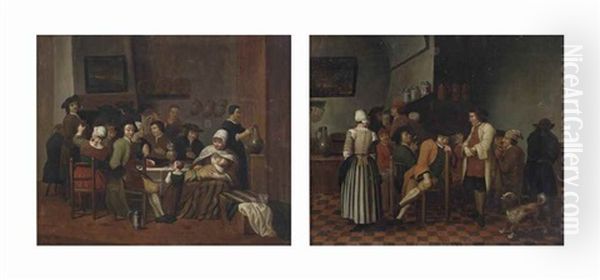
His compositions are typically well-structured, often using architectural elements like doorways or windows to frame the scene or create depth. Figures are arranged thoughtfully to create a narrative flow, encouraging the viewer's eye to move through the space and observe the interactions. Horemans paid close attention to detail, capturing the textures of clothing, the sheen of metal objects, and the play of light across surfaces. This detailed realism lends authenticity to his scenes, making them valuable historical documents as well as works of art.
While influenced by the 17th-century tradition, Horemans the Younger adapted it to 18th-century tastes. His figures, while sometimes retaining a certain solidity reminiscent of his father's work, can also exhibit a greater degree of refinement and animation. His palette, though sometimes employing the darker tones associated with his father (leading perhaps to confusion around nicknames like 'Le Brun' or 'the Brown', which might more accurately apply to the Elder), could also be lighter and more varied, particularly in scenes depicting wealthier interiors or outdoor settings. He was skilled in using red chalk for preparatory drawings, showcasing his draughtsmanship.
Themes and Subjects: A Mirror to Society
The thematic range of Horemans the Younger's work is broad, covering various strata of Antwerp society. He frequently painted scenes of bourgeois family life: musical parties, card games, meals, and conversations in well-appointed rooms. These paintings often highlight the material comforts and social graces of the emerging middle class. Works like Elegant Company Making Music or A Merry Company exemplify this aspect of his oeuvre, showcasing fashionable attire and leisurely pursuits.
He also depicted scenes of labor and professional life. Perhaps his most famous work in this category is Interior with a Surgeon and His Apprentice Attending to a Patient. This painting offers a fascinating glimpse into 18th-century medical practices, rendered with Horemans' characteristic attention to detail and narrative clarity. Similarly, his painting Boys’ School provides insight into educational settings of the time. These works move beyond simple observation, often containing subtle social commentary or highlighting the roles and interactions within specific professions.
Tavern scenes, a staple of Flemish genre painting since the time of Adriaen Brouwer and David Teniers the Younger, also feature in Horemans' output. He depicted drinkers, smokers, and card players in these more rustic settings, capturing the boisterous energy and camaraderie of common life. Additionally, he painted courtyard scenes and occasional outdoor gatherings, such as the Portrait of an Elegant Family Group in a Park Landscape, demonstrating his versatility in handling different settings and group dynamics.
Representative Works and Notable Paintings
Several key works help define the contribution of Jan Josef Horemans the Younger:
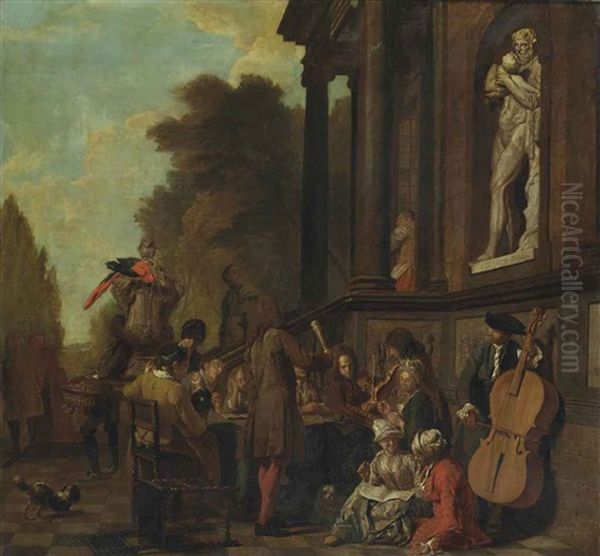
Interior with a Surgeon and His Apprentice Attending to a Patient: Held in several versions, this subject showcases Horemans' ability to create a compelling narrative within a detailed interior. The focus on the medical procedure, the expressions of the figures, and the carefully rendered instruments make it a standout piece, illustrating both his artistic skill and his role as a social documentarian.
Boys' School / Village School: Also existing in multiple versions, these paintings depict the interior of a classroom, often showing a stern schoolmaster and pupils engaged in various states of learning or mischief. They offer valuable insights into 18th-century education and childhood, rendered with Horemans' typical blend of realism and anecdotal detail.
Elegant Company Making Music / The Music Party: These works capture the refined atmosphere of bourgeois social life. Figures are shown playing instruments like the cello, flute, or harpsichord, dressed in fashionable attire within elegantly furnished rooms. They reflect the growing importance of music and leisure among the middle and upper classes.
Portrait of an Elegant Family Group in a Park Landscape: This work, sold at auction, demonstrates Horemans' ability to handle larger group portraits and outdoor settings. It combines portraiture with genre elements, placing the family within an idealized landscape, reflecting contemporary trends in portrait painting influenced by artists like Gonzales Coques from an earlier generation.
Hercules und Antaios: This painting, depicting a mythological subject, is somewhat unusual within Horemans' typical oeuvre. Its interpretation and attribution have been subject to discussion, with debates surrounding its meaning – whether allegorical or a straightforward mythological depiction – and its place within the Horemans family output. Such works highlight the complexities sometimes involved in assessing his full range.
Context: Antwerp in the Eighteenth Century
Jan Josef Horemans the Younger worked during a period of relative stability but diminished international prominence for Antwerp compared to its 17th-century zenith. While the city was no longer the powerhouse driving Northern European art as it had been under Rubens, it maintained a solid artistic infrastructure, including the venerable Guild of Saint Luke, which regulated the training and practice of artists.
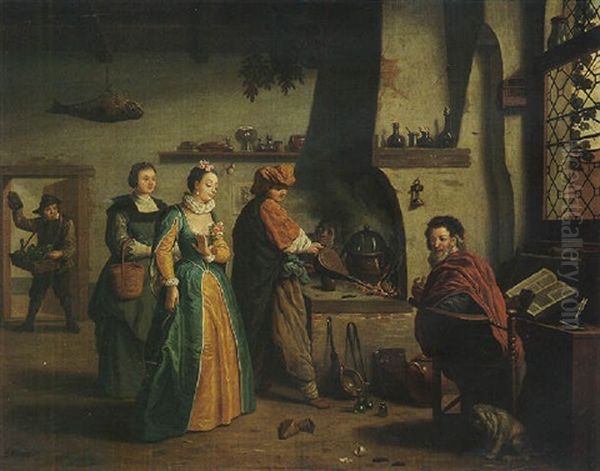
The artistic landscape was populated by painters catering to a local market of bourgeois patrons, merchants, and the nobility. Genre painting, portraits, still lifes, and landscapes remained popular. Horemans the Younger was a leading figure in Antwerp genre painting during his time. Other notable Antwerp artists active during or overlapping with his career included Balthasar Beschey (known for history paintings and portraits), Peter Snyers (still life and genre), and Gerard Thomas (studio and alchemist scenes). The influence of earlier masters like David Teniers the Younger remained pervasive.
Looking slightly broader, the artistic scene in the Low Countries included figures like the Dutch painter Cornelis Troost, who also specialized in genre scenes and theatrical conversations, offering a parallel development in the Northern Netherlands. While direct influence from French Rococo painters like Jean-Antoine Watteau or Jean-Baptiste-Siméon Chardin might be less pronounced in Horemans' generally more earthbound style, the overall European trend towards lighter themes and more intimate scenes likely had some resonance in Antwerp as well. Peter Jacob Horemans, a relative, found success as a court painter in Munich, indicating the diaspora of Flemish artistic talent.
The Attribution Challenge Revisited
The difficulty in distinguishing Jan Josef Horemans the Younger's work from that of his father (and potentially his brother) remains a central issue in his study. This confusion impacts not only individual attributions but also the overall assessment of his artistic development and originality. Did he closely follow his father's style throughout his career, or did he forge a more independent path? How did the market perceive their works – were they sold interchangeably, or was a distinction made?
Art historians rely on subtle stylistic differences: the Younger's work is sometimes seen as having slightly more elongated figures, a smoother finish, and occasionally a brighter palette or more Rococo-influenced compositions compared to the Elder's more robust, earthy style rooted in the 17th century. However, these distinctions are not always clear-cut, especially as the Elder lived until 1759, overlapping significantly with the Younger's active period. Documented commissions or dated works are crucial anchors for establishing a more secure understanding of each artist's contribution.
This ongoing attribution debate underscores the importance of provenance research and technical analysis in studying the Horemans family. It also highlights how familial workshops and shared names could complicate artistic legacies, particularly before the modern era of meticulous record-keeping and distinct artistic branding.
Guild Membership and Professional Standing
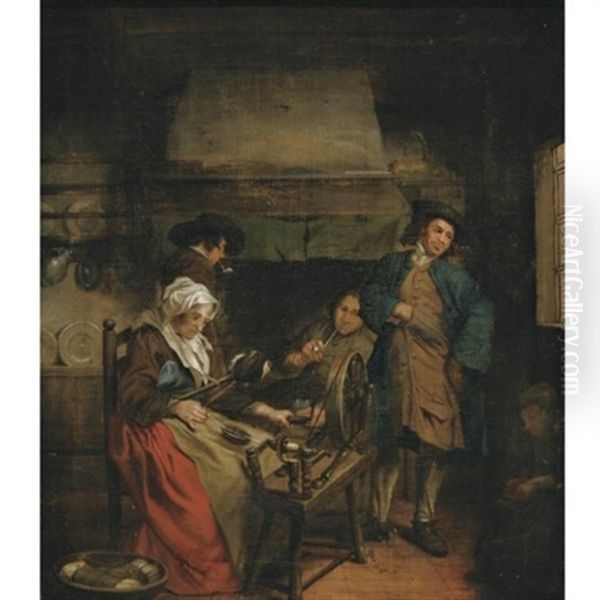
Despite the potential confusion with his father, Jan Josef Horemans the Younger achieved recognition in his own right within the Antwerp artistic community. He became a master in the prestigious Guild of Saint Luke in 1767. Membership in the guild was essential for practicing professionally as an independent artist in Antwerp. It signified that he had completed his training and met the required standards of craftsmanship.
His acceptance as a master relatively late in his career (he would have been in his early 50s) might reflect the long shadow cast by his father, who had been a prominent guild member much earlier. Alternatively, it could simply reflect the standard progression for artists at the time. Regardless, his membership confirms his status as a recognized and respected painter within the city's official artistic structure. His position allowed him to take on apprentices and sell his works openly, contributing to the continuation of Antwerp's artistic traditions.
Later Life, Legacy, and Influence
Jan Josef Horemans the Younger continued to paint throughout the latter half of the 18th century, dying around 1790 or 1792. His long career resulted in a substantial body of work that collectively offers an invaluable visual record of Antwerp life during his time. While perhaps not an innovator on the scale of the 17th-century masters, he was a highly skilled practitioner who successfully adapted the Flemish genre tradition to contemporary tastes.
His legacy lies primarily in his detailed and engaging depictions of everyday activities. These paintings provide historians with rich information about clothing, furniture, social customs, and professions of the period. For art lovers, they offer charming and often narrative-rich glimpses into the past, executed with considerable technical skill. His influence can be seen in the continuation of genre painting traditions in Belgium into the 19th century.
While overshadowed by bigger names from earlier periods, Horemans the Younger's work maintained its appeal. His paintings found their way into numerous private and public collections across Europe. Today, his works are held by major museums, ensuring his contribution to Flemish art history is preserved and accessible.
Collections and Market Presence
Works by Jan Josef Horemans the Younger are represented in significant museum collections worldwide. Key institutions holding his paintings include:
The Royal Museums of Fine Arts of Belgium, Brussels
The Royal Museum of Fine Arts Antwerp (KMSKA)
The Gemäldegalerie, Berlin
The Kunsthistorisches Museum, Vienna
The Louvre, Paris
The Rijksmuseum, Amsterdam
Various regional museums in Belgium, the Netherlands, France, and Germany.
His paintings also appear regularly on the art market at auctions. Prices can vary widely depending on the size, subject matter, condition, and certainty of attribution. While generally not reaching the astronomical figures of top-tier Old Masters, his works are sought after by collectors of Flemish genre painting. Auction records show sales ranging from a few hundred euros for minor works or drawings to several thousand pounds or euros for well-preserved and characteristic paintings like the Portrait of an Elegant Family Group. This market presence indicates a continued appreciation for his skillful depictions of 18th-century life.
Conclusion: A Valued Flemish Genre Painter
Jan Josef Horemans the Younger occupies a solid place in the history of 18th-century Flemish art. As a dedicated painter of genre scenes, he meticulously documented the world around him in Antwerp, from the drawing rooms of the bourgeoisie to the humble interiors of schools and workshops. Working within a strong family tradition, and alongside a father and brother of the same name, his individual artistic identity has sometimes been obscured, presenting challenges for attribution.
Nevertheless, his skill in composition, his eye for detail, and his ability to capture the nuances of social interaction are evident in his extensive body of work. He successfully carried forward the legacy of earlier Flemish masters like David Teniers the Younger while adapting the genre to the sensibilities of his own time. His paintings remain valuable not only as charming works of art but also as important historical documents, offering a rich and detailed panorama of life in 18th-century Antwerp. His presence in major museum collections and his continued appearance on the art market testify to his enduring, if quiet, significance.